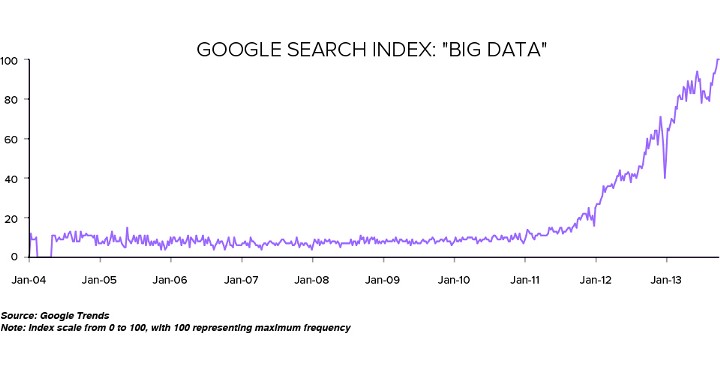
“But far more numerous was the herd of such, who think too little, and who talk too much”
– John Dryden

Introduction
The term ‘big data’ is a pervasive Silicon Valley colloquialism. The expression now describes a range of technologies, from back-end infrastructure to front-end consumer software applications. This development corresponds with a trend: the allocation of billions of dollars by investors into ‘big data’ companies which, simply put, stand little chance of becoming transformative companies.
This statement may be unexpected coming from a group which is frequently identified with ‘big data’ companies. To be certain, we focus on a subset of ‘big data’: Smart Enterprise Data Platforms, which we described in Platform Plays and elsewhere. The term, however, has grown to encompass a much larger (and far less valuable) group of companies.
The chart above illustrates the rapid conventionalization of ‘big data’ over the past two years. This should scare investors. We remember there was much truth behind the “new economy paradigms” of the late 90′s, but most of the resulting companies were nonsense. As investors we know that investing along popular sentiment leads to crowded trades and lost money, and this time it won’t be any different.
What are the most common mistakes being made in the area? We offer five archetypes of investments to avoid as well as positive attributes of the Smart Enterprise companies we focus on. We hope these will help guide entrepreneurs to properly allocate their time and investors to better allocate their capital.
Joe Lonsdale
Partner, 8VC
Drew Oetting
Partner, 8VC
Common ‘Big Data’ Archetypes to Avoid:
Dashboards, Visualization Tools and Presentation Layer.
Making data consumable is vital, and a fundamental feature of a Smart Enterprise company. Visualization, however, is just that — a feature. Standalone companies create the bulk of their value by using proprietary data to continuously improve work flows and build network effects, not simply displaying it. Dashboards are one feature of a Smart Enterprise company, but rarely represent a successful company’s core value proposition. We see Tableau (NYSE:DATA) as an exception which proves the rule — a well-executed first mover which leaves little room (or need) for competition.
Horizontal Business Intelligence and Analytics.
Structuring data and drawing insights is vital for companies, especially given the exponential growth in data created by modern enterprises. This data is often disparate and idiosyncratic. Companies that are industry agnostic ignore the importance of owning and understanding work flows in structuring data. We see these companies facing three common pitfalls: 1) They fail to produce a product which is differentiated; 2) They over-build the technology and never produce a product; or 3) They are forced to customize to win customers, and become more a consultancy than a platform.
Artificial Intelligence and Predictions.
Advances in data science and software engineering have paved the way for computers to contribute in decision-making, but automation of strategic thinking is still science fiction. Companies that base their value proposition off of making predictions or replacing high-skill knowledge workers ignore the limitations of computers and the realities of selling a product. AI plays a vital role in many Smart Enterprise companies. But we do not invest in “black-box” algorithms; we invest in companies which use the power of computers to structure data and expose results for people to use. “Black boxes” are rarely valuable in their own right, and when they are, they are not billion dollar companies. As stated previously in The Smart Enterprise Wave, our interest is in technology which augments and extends the human mind, not that which attempts to replace it. One day, there may be an exception; but AI and predictive technology is not a coherent business strategy.
Reliance on Partnerships for Data / No Ownership of Infrastructure.
The key to generating proprietary data is owning infrastructure, and in many industries the infrastructure seems locked away by incumbents. Examples include EMRs in healthcare, inter-bank networks in financial services and hardware in agriculture. Many ambitious young companies partner with incumbents to access data. This approach is a sound one; in many cases infrastructure is so entrenched in core work flows that partnership is the logical first step. However, this dependence means companies are constantly at risk of being held hostage. Smart Enterprise companies mitigate this risk by aligning incentives and creating inter-dependency with necessary partners, and then quickly work to build work flow tools which turn user engagement into proprietary data.
Company solves a Technology Challenge, not a Business Need.
The increase in data generated by enterprises has presented a variety of difficult technical problems. Many of the top data scientists and software engineers are excited by these problems, and are building companies to bring their solutions to market. While intellectually interesting, not all of the technical challenges presented by increasing data scale are valuable to businesses. We find a great number of clever technologists (especially in more academic geographies such as Boston) who start with an intriguing technology solution and then search for a business application. We believe the most valuable companies solving real problems will be vertically focused and have direct influence on crucial business processes. These companies empower knowledge workers to directly create ROI — they are not clever technology which sits as middleware or back-end infrastructure.
Key Aspects of a Smart Enterprise Company
Vertically Focused Work Flow Software.
Certain business functions are similar across industry verticals and therefore are appropriately served by horizontal platforms (e.g. Workday, RelateIQ). However, ‘front-office’ roles (which tend to be the main driver of business success) demand software which is specialized. Building software which standardizes the best practices from the industry improves these vital workflows, and in doing so previously disparate meta data produced by engagement is now structured and ‘purpose built’ to be re-introduced in a meaningful way.
Network and Platform Effects.
Advances in computer science, data storage, and infrastructure have made software more cost efficient to create. While this phenomenon has driven innovation, it has also reduced technical barriers to entry in software. Entrepreneurs must thoughtfully architect defensibility into their business models; it is not enough to deliver a better and cheaper solution. Companies should structure solutions where each additional client brings more value to the platform. For example, networks are strengthened when additional clients contribute relevant data that can be used (anonymously if needed) by the broader customer base, or when an ecosystem of applications develops on top of the platform.
Solves a Real Business Problem (Corollary: Replace Existing Spend).
Smart Enterprise companies are first and foremost technology driven, but to succeed they must also solve current problems for business. The most critical business needs are almost always manifested on the income statement; identifying the line item being targeted is crucial. That isn’t to say that the analogy is obvious to find — a quill and a printing press look quite different — but a successful company will be laser focused on the cost center it seeks to usurp. It is rare that an immediate business challenge isn’t being tackled in some way, so be skeptical of companies looking to solve a problem that is currently completely ignored. Many times this is evidence of a non-problem, a sign of a fundamental lack of domain expertise, or the premonition of an impossibly long sale cycle.
Conclusion
There has been a shift in market focus from consumer to enterprise technology over the past two years, resulting in a proliferation of companies looking to leverage data. We are excited as well, but we caution over-optimism. We urge investors and entrepreneurs alike to think beyond ‘big data’ and study the workflows and challenges facing our economy’s key industries.
The promise of the Smart Enterprise wave is radical improvement to the core workflows of industry. These new companies will improve outcomes in healthcare, drive transparency in finance and transform energy infrastructure, among other improvements. Building these companies is not easy. Billions of dollars and man hours will be wasted by ‘big data’ companies which fail to target the right areas. This is a shame. We urge investors and entrepreneurs to re-focus on solving proven business problems in the core industries of our economy. With human and financial capital properly allocated, we are optimistic humanity will realize increases in prosperity at a rate never experienced before.

